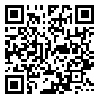Volume 14, Issue 6 (February-March 2012)
J Arak Uni Med Sci 2012, 14(6): 48-56 |
Back to browse issues page
Download citation:
BibTeX | RIS | EndNote | Medlars | ProCite | Reference Manager | RefWorks
Send citation to:



BibTeX | RIS | EndNote | Medlars | ProCite | Reference Manager | RefWorks
Send citation to:
Behnam-Rassouli M, Ghayour N, Ghayour M, Ejtehadi M. Investigating the effects of hydro-alcoholic extract of Launaea acanthodes on the serum levels of glucose, insulin, lipids and lipoproteins in stereptozotocin induced type I diabetic rats. J Arak Uni Med Sci 2012; 14 (6) :48-56
URL: http://jams.arakmu.ac.ir/article-1-1007-en.html
URL: http://jams.arakmu.ac.ir/article-1-1007-en.html
1- , behnam@ferdowsi.um.ac.ir
Abstract: (17919 Views)
Background: Launaea acanthodes is used as a common medicinal plant in central regions of Iran. To investigate the probable hypoglycemic activity of hydro-alcoholic extract of L. acanthodes as well as its effects on serum level of insulin and biochemical factors in normal and hyperglycemic rats, the present study was carried out.
Materials and Methods: In this experimental study 24 male albino Wistar rats, weighting 250-300 g were randomly allocated into four groups (n=6) control, type 1 diabetic rats (STZ 55 mg/kg), type 1 diabetic rats treated by subcutaneous injection of 5 IU/kg insulin (STZ+insulin) and type 1 diabetic rats treated by injection (i.p) of 150 mg/kg hydro-alcoholic extract of L. Acanthodes (STZ+extract). The injection of insulin and extract were done every day from day 1 to day 21 of experiment. After that, all animals were kept up to day 30. Blood serum were collected and analyzed for the levels of glucose and biochemical factors (cholesterol, triglyceride, LDL and HDL) measurements, in the 15th and 30th day of experiment.
Results: The results showed significant decrease (p<0.001) in glucose level and significant increase (p<0.05) in insulin level in STZ+extract group, when compared with other hyperglycemic groups in 30th day of experiment.
Conclusion: These results indicate that the hydro- alcoholic extract of L.acanthodes could be effective in the treatment of diabetes. It can be concluded that extract administration somehow induce insulin secretion probably through stimulation of remaining β cells or their hyperplasia in Langerhans islets. This effect can also be referred to flavonoides constituent and antioxidant property of extract, too.
Type of Study: Original Atricle |
Subject:
Basic Sciences
Received: 2011/01/10 | Accepted: 2011/06/15
Received: 2011/01/10 | Accepted: 2011/06/15
Send email to the article author
| Rights and permissions | |
 |
This work is licensed under a Creative Commons Attribution-NonCommercial 4.0 International License. |





